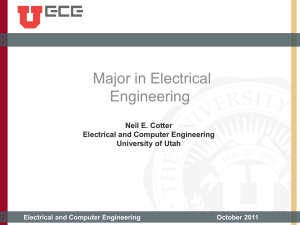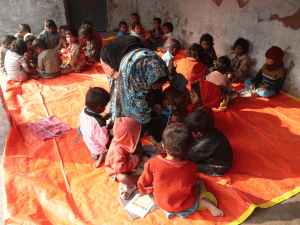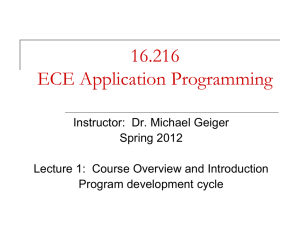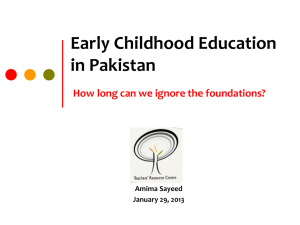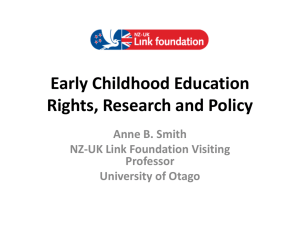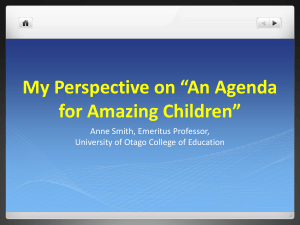Amima Sayeed
advertisement
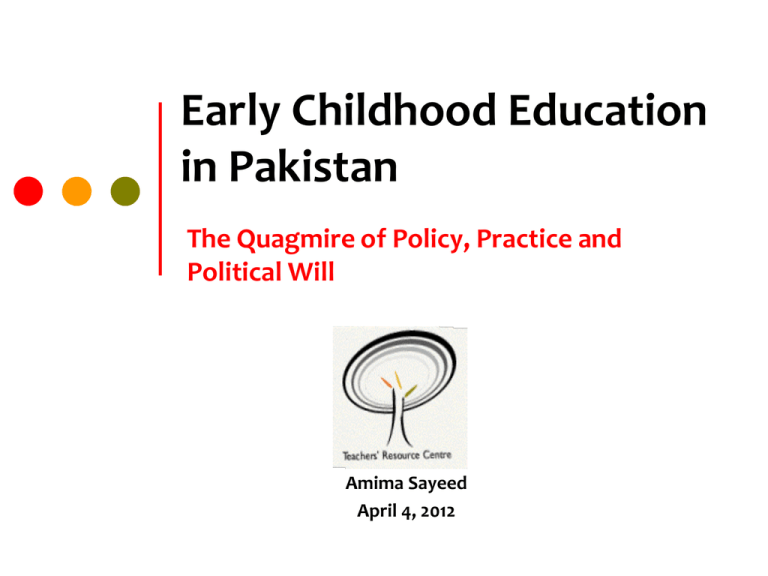
Early Childhood Education in Pakistan The Quagmire of Policy, Practice and Political Will Amima Sayeed April 4, 2012 Policies and Provisions: What’s Been Achieved? National Curriculum aligned with the developmental domains Contextualized, consultative and research based Frameworks for classroom implementation in rural and urban areas for ECE Specific policies for ECE introduction, budgetary provisions and plans across Pakistan A fantastic mix of technical and grassroots expertise for Teacher Education, follow-up and support Promised Policy Provisions in Pakistan – 1998-2010 Recognition and strengthening of Katchi class as part of formal system and opening of Katchi/ECE classes in the public sector primary schools as the main strategy for increased access. Full-time teachers for katchi class/pre-primary education will be trained and recruited. Curricula development for ECE and coordinate for development of teaching-learning materials. Instructional material, teaching kit and A.V. Aids for ECE will be developed and provided to ECE centers and schools. Free provision of Activity-based textbook (Qaaida) and other learning material for pre-primary education From NEP 2009 to RTE (Article 25-A) Gross Enrolment Ratio (GER) for ECE is 99% in 2007-08 (despite 7.3 million out of school children) At least one year pre-primary education shall be provided by the State and universal access to ECE shall be ensured within the next ten years. Provision of financial and food support to children who drop out because of poverty at ECE Two year pre-service training to ECE teachers based on NCECE Pre-Primary Enrolments by Gender and Area (2006-07) Male Female Total Urban 304,286 295,873 6 00,159 Rural 2,200,350 1,755,209 3,955,559 Total 2,504,636 2,051,082 4,555,718 Source: AEPAM 2008 Reality Bites: On ground Situation of ECE Curriculum developed in 2007 has yet NOT reached all districts of Pakistan let alone teachers ECE is NOT included in the primary cycle with implications on Finalization and notification of Urdu version of the Curriculum has not happened yet. ECE regularization, New Staff Positions, financial resources, monitoring & quality of learning environment Lack of accurate data required for planning ECE programmes No coordination, nodal points, focal persons and budgets! Developmentally Inappropriate Practices: Out of the frying pan, into the fire Out of School Children Trapped if born into illiteracy, disinformation and poverty No exposure to tools leading to critical thinking Societal trend of disrespecting child’s views and independence Economic pressures, forced and hazardous labour Family disharmony, experience of abuse In –school Children Hazardous physical environment Instruction not interaction or engagement If at all, unaware and illequipped teachers Labeling, profiling, bullying – set up for early failure Damning emphasis on writing & discipline! Monolithic systems Kills the innate creative potential and diversity Ensuring Strong Foundations at Scale Moving from franchised to contextualized models need for adapting the curriculum and classroom resources for meeting the diverse needs of 38yrs calculating unit costs on the basis of essential learning conditions and not just infrastructural requirements Striking a balance between “donor driven activities”, “rapid pace of implementation” and “taking stock of experiences” Improvement of ECE Quality at Scale Immense need for developing deeper understanding of “how learning takes place” Subtracting practices that are embedded in behaviorist learning approach Developing learning webs within and outside school to promote healthy relationships and pro-social attitude Promoting a culture of reflective practice to avoid mechanistic implementation of ECE curriculum Ensuring Strong Foundations at Scale Social and public accountability People to ask the political leaders about the promises before re-election NGOs, Community Groups even School Committees must push the government to fulfill its commitments Tracking of funds transfer and per child/per school allocation Pulling the strings to push for ECE at individual, institutional, taluka, district, provincial, sectoral and national levels Health, Social Welfare, Women’s Welfare and Education ministries to align their targets and mechanisms Academicians and researchers challenging the inadequate plans and presenting BETTER options




